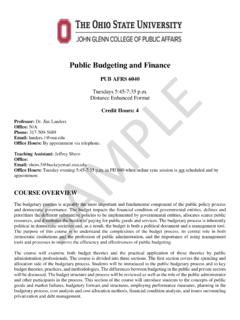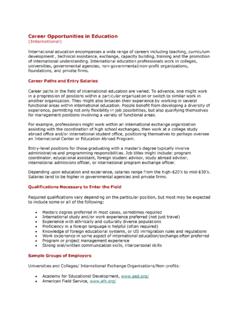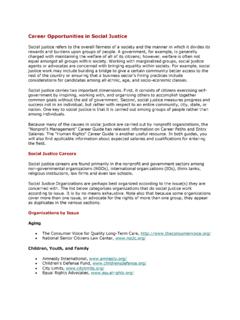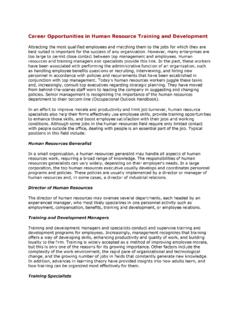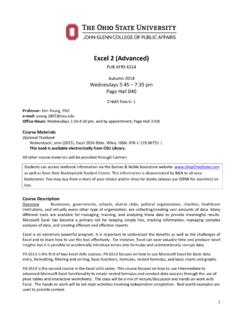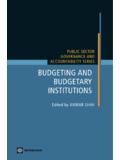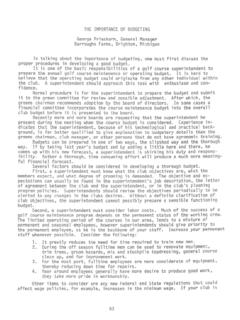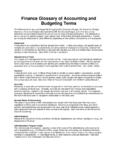Transcription of Public Budgeting and Finance - John Glenn College of ...
1 1 | Page Public Budgeting and Finance PUB AFRS 6040 Mondays 5:45 9:20 Hagerty Hall, Room 062 Credit Hours: 4 Professor: Dr. Charlotte Kirschner Office: 310B Page Hall Phone: 614-292-7221 Email: Office Hours: Tuesdays 3 to 5 , or by appointment Teaching Assistant: Jongsoo Park Office: 240A Page Hall TA Email: Office Hours: Tuesdays 10 to noon, or by appointment COURSE OVERVIEW Funding for Public programs is inseparable from the operation of those programs. All Public managers, therefore, find themselves needing knowledge and skills in the principles of Public Finance and Budgeting . Whether you are an official who is immersed in Public Budgeting on a day-to-day basis, or you are one who must make policy based on the relationship between dollars and program goals and objectives, understanding these concepts is vital to both your personal success and the success of your organization.
2 This course in Public Budgeting & Finance provides the policy & management oriented student an opportunity to think about proper financial administration of the Public sector in the economy. The course examines the motivations for creating a Public sector, contemplates budgets as political, policy, and financial documents and discusses methods for Budgeting and budget analysis. We will consider a variety of techniques for the analysis of revenues, spending and the issuance of debt. We will study methods of revenue collection and forecasting, explore tax expenditures, deductions, and credits, and the reasons they have become prominent tools for implementing policy. The course will culminate in the examination of how the Public sector finances the provision of service in five policy areas.
3 2 | Page STUDENT LEARNING GOALS AND OBJECTIVES Upon completion of this course, students will: 1. Have a working knowledge of processes, principles, and techniques employed by those who develop, manage and analyze budgets in the Public sector; 2. Become familiar with a wide variety of analytical techniques appropriate for the analysis of revenue, spending, and debt issuance; 3. Develop a greater capacity to conduct analyses using Microsoft Excel or a similar spreadsheet package; and 4. Develop skills in professional writing. PREREQUISITES Students are expected to have completed Public Affairs 6030, Public Sector Economics, or a similar intermediate-level microeconomics course. REQUIRED TEXT AND READINGS Students can access textbook information for via the Barnes & Noble bookstore website: as well as from their BuckeyeLink Student Center.
4 This information is disseminated by B&N to all area bookstores. You may buy from a store of your choice and/or shop for books (always use ISBN# for searches) on line. There is one required text for the course: Public Budgeting Systems (9th edition), by Robert D. Lee, Jr., Ronald W. Johnson and Phillip G. Joyce. ISBN#978-1449627904 The text is supplemented by readings that are available on the Carmen website. Public Budgeting issues are very much in the news these days and we will be using current events as a method for learning and applying the concepts discussed in this course. Therefore, students are strongly encouraged to read The New York Times, The Washington Post, The Wall Street Journal, The Columbus Dispatch or similar newspapers.
5 GRADING The course is graded A-E, based on a total of 100 points, with point distribution outlined in the course requirements section. Transformation of numerical grade to letter grade will be according to the schedule below: A 93 100 B- 80 82 D+ 68 69 A- 90 92 C+ 78 79 D 64 67 B+ 88 89 C 73 77 E 63 and below B 83 87 C- 70 72 3 | Page COURSE REQUIREMENTS There will be five components used in determining your final grade for the course. This section describes these requirements and their relative weights for your final grade. Class Participation 5% Optional Midterm Exam 20% Homework Assignments 45% Issue Discussion 10% Final Exam 20% to 40% Class Participation: Active and constructive participation in class discussion is a critical part of this course, making attention to the assigned readings particularly important.
6 Students are expected to attend each class session and come prepared to discuss questions raised by the readings. You can participate in class in many ways, including answering questions during class discussion; asking questions to clarify class discussions; and/or volunteering personal experiences to a case or concept discussed in class. If you are absent from class, you must make arrangements to obtain notes and handouts from other students or me. Class participation represents 5% of your final grade. Homework Assignments: Three assignments will be required for this class. The assignments ask students to apply their knowledge to conduct tax and budget analyses and to summarize their work in short policy memos. Specific instructions for the written assignments will be passed out in class at least two weeks before they are due.
7 Each written assignment will be worth 15% of your grade, for a total of 45% of your final grade. Issue Discussion: Each student will select a topic to engage the class in a short discussion of a Public budget and Finance issue. You are responsible for applying the course material for the week to a specific issue that can be discussed by the class. Topics will be assigned before the second class session. Additional details will be distributed in class. The issue discussion represents 10% of your final grade. Midterm and Final Examinations: Two exams will be administered. Exam questions will consist of multiple choice, short answer, and/or essay. The optional midterm represents 20% of your final grade and the final comprehensive exam represents another 20% of your final grade.
8 For students electing not to take the midterm exam, the final exam will be worth 40% of the final grade. There will be no make-up exams. If you are absent from the midterm exam, the weight of that exam will be applied to the final exam. The final exam will be scheduled during the University s final exam period for this course. Failure to take the final exam at the scheduled time will result in a grade of zero on the final exam. 4 | Page COURSE POLICIES Academic Integrity/ Academic Misconduct Policy From: #academicmisconductstatement The Ohio State University and the Committee on Academic Misconduct (COAM) expect that all students have read and understand the University s Code of Student Conduct, and that all students will complete all academic and scholarly assignments with fairness and honesty.
9 Failure to follow the rules and guidelines established in the University s Code of Student Conduct may constitute Academic Misconduct. Sanctions for the misconduct could include a failing grade in this course and suspension or dismissal from the University. In the Ohio State University s Code of Student Conduct, Section 3335-23-04 defines academic misconduct as: Any activity that tends to compromise the academic integrity of the University, or subvert the educational process. Examples of academic misconduct include (but are not limited to) plagiarism, collusion (unauthorized collaboration), copying the work of another student, and possession of unauthorized materials during an examination. Ignorance of the University s Code of Student Conduct is never considered an excuse for academic misconduct.
10 Other sources of information on academic misconduct (integrity) to which you can refer include: The Committee on Academic Misconduct web page: Ten Suggestions for Preserving Academic Integrity: Eight Cardinal Rules of Academic Integrity: If you have any questions about the above policy or what constitutes academic misconduct in this course, please contact me. Writing Style and Citations All written work for this class should be well organized, written, and edited. If you have concerns about your writing or struggle with writing consider working with OSU s Writing Center ( ). All work should be original. Paraphrasing or quotation of other s works including, but not limited to, information from websites, promotional materials, lecture slides, and texts without proper attribution will not be accepted.
